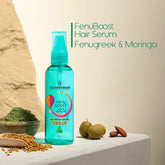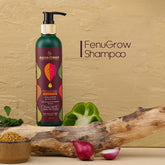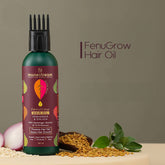Best Ayurvedic Hair Remedies To Treat Split Ends

Are your split ends reappearing despite regular trimming? Don't worry, you won't have to shave your gorgeous mane to keep them at bay. Split ends are a frequent issue, and shortening your hair may not be a long-term cure. You may, however, control them with ayurvedic hair remedies that have no negative effects. Scroll down to learn about the best ayurvedic hair remedies for split ends and how they may help you resurrect the health of your hair. But first, let us learn about what are split ends and the factors that lead to that?
What are Split Ends?
Briefly said, split ends are caused by the splitting of your hair shaft, which is known clinically as Trichoptilosis. Split ends are classed as 'Shiro Roga,' or a condition of the head, in Ayurveda. But first, let's take a look at the anatomy of your hair shaft to see how it divides.
Your hair shaft is composed of three layers. The medulla is the deepest layer. The cortex is the second layer, which is made up of the protein Keratin. This layer also includes melanin, which is responsible for the color of your hair. Keratin strengthens your hair and keeps it from breaking. The cuticle is the third and outermost layer, which is made up of dead cells that overlay like scales.
Split ends develop when your cuticle is injured by external sources like as heat or excessive sun exposure, exposing the cortex. As a result, the keratin layer separates or unravels, resulting in a split in your hair shaft.
"Rasa dhatu, which is often related to lymph, assists in the retention of hair moisture," says Ayurveda. Hair breaks at the ends because of rasa dhatu rupture. Good hydration, sound digestion, including healthy fats in the diet, and heat shielding all help to balance the Rasa dhatu, which feeds the hair.
Types of Split Ends

Split ends signify that your hair requires care and conditioning. As a result, it is critical to understand the various types of split ends in order to recognize them.
Factors Contributing to Split Ends
- Excessive sun exposure: Too much ultraviolet (UVA and UVB) light from the sun damages the cuticle of your hair shaft, causing it to split. People who spend a lot of time in the sun are prone to photodamage. UVB rays penetrate the hair shaft and destroy the disulphide bonds on the cuticle's surface, promoting hair porosity. As a result, the hair strands become harsh, fragile, and prone to breaking.
- Overuse of Heat Styling Products: As much as you relish discovering new hair products, it is critical to understand what is in the package. Several chemicals in shampoos, serums, gels, and other hair care products include toxins that, when used over an extended period of time, rob your natural sheen. Ingredients like Laureth Sulphate, Chemical Fragrances, Parabens, Propylene Glycol, and Sodium Chloride damage the keratin layer, causing hair breakage and split ends.
- Mechanical Stress Wear and Tear: That last-minute brushing might be quite damaging to your hair. Hair can generally be stretched by 30%, however, extending it beyond that may cause structural damage. Rough combing, wearing frequent head coverings, tighter ponytails, and sleeping on cotton pillows can cause your hair to break from the ends.
- Heat Stress: Split-ends are typical in regularly styled hair due to heat damage. Straighteners, blow dryers, and curling irons damage your hair's protein linkages, causing it to break easily. If you must blow-dry your hair, we recommend that you use a lower heat setting to avoid further damage.
- Sweat and abrasive water: Before diving into the water, don't forget to put on your swim cap. Chlorine in water, as well as harsh minerals, can damage your hair's cuticle, resulting in split ends. Swimming pool hypochlorous acid, hard minerals like copper in tap water, and sweat may all dissolve the cuticle, leaving your hair stiff, brittle, and frizzy.
Now that you know what's causing your split ends, attempt to avoid them as much as possible. Meanwhile, let's have a look at some ayurvedic hair remedies for split ends.
Ayurvedic Hair Remedies to Treat Split Ends
- Shankhpushpi Oil: Shankhpushpi Oil’s Rasayana (rejuvenating) power prevents premature greying, reduces hair fall, and aids in hair growth, consequently enhancing the overall hair texture.
- Geranium Oil: Geranium keeps the scalp's pH balanced by thorough cleansing and regulating sebum production. It effectively removes impurities and product residue from the scalp and hair, allowing color to penetrate and cover greys without causing hair damage. It has astringent properties that provide gentle hydration and a natural shine to the hair.
- Bhringraj Oil: Bhringraj, sometimes known as "the herb king," is a mystical plant. It promotes hair growth by improving blood circulation in hair follicles and seeps deeply into the scalp to alleviate dryness. It contains a lot of iron, magnesium, and vitamins E and D. It also alleviates the itching and greasiness associated with dandruff.

- Fenugreek: Methi (Fenugreek) is an excellent elixir for critical hair care and scalp wellness, capable of healing virtually any hair disease. Methi seeds have traditionally been used to treat hair loss and fall, itchy scalp, extreme dryness or oiliness, and premature greying.
- Aloevera: It includes vitamins A, C, and E, which maintain healthy and glossy hair by assisting with cell turnover. Because of its antifungal, antibacterial, and therapeutic characteristics, it relieves itching and irritation while also increasing shine and strength. It also thoroughly cleanses the hair shaft, reducing excess sebum while preserving the integrity of the hair.
- Tulsi: Its anti-bacterial and anti-fungal properties assist to keep the scalp healthy while also keeping it moist. This substance, which is strong in antioxidants and Vitamin K, promotes blood flow in the follicles and helps to prevent hair loss.
- Ginger: The antibacterial and antiseptic properties of ginger keep the scalp clean and so prevent dandruff. It increases blood flow to the scalp, stimulates hair growth, and strengthens hair follicles. Ginger includes fatty acids, vitamins, and minerals that assist to thicken hair and keep it from falling out.
What if we told you that you could use both of these products at any time and offer your hair the nourishment of both an oil and a serum? Yes! You heard correctly. For the first time, Manestream has launched a breakthrough product, Fenupro Seroil, which combines the benefits of both a serum and an oil. This one-of-a-kind, 100% ayurvedic combination provides the comfort and nutrition of oil and serum without leaving the hair greasy or sticky. This unique multi-purpose seroil contains Fenugreek, Green Tea, and oil extracts to keep hair looking shiny and smooth while also hydrating the scalp and hair.
Getting rid of those split ends is always an option. If your split ends are severe and cannot be treated with natural remedies, you will need to have your hair trimmed to keep it from splitting further. In the event of long hair, we recommend getting it trimmed on a regular basis and then using the hair cures indicated above to keep those split ends from reappearing.





